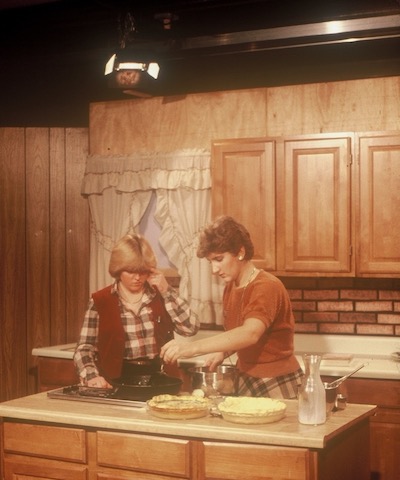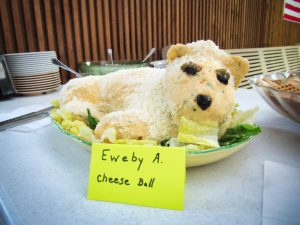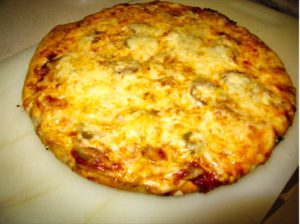 Welcome back to FSHN Research Journeys, a series that follows the research of graduate students in the Food Science and Human Nutrition program at UF. Today’s guest poster is Sharyn Passeretti, a former chef and current FSHN lab manager who will pursue her master’s degree in food science and human nutrition under the mentorship of Dr. Renee Goodrich-Schneider. In this article, discover her inspiration for studying gluten-free products, her career in food service, and a special recipe for readers.
Welcome back to FSHN Research Journeys, a series that follows the research of graduate students in the Food Science and Human Nutrition program at UF. Today’s guest poster is Sharyn Passeretti, a former chef and current FSHN lab manager who will pursue her master’s degree in food science and human nutrition under the mentorship of Dr. Renee Goodrich-Schneider. In this article, discover her inspiration for studying gluten-free products, her career in food service, and a special recipe for readers.
Sharyn: Imagine biting into a chewy chocolate chip cookie or taking a bite of a flavorful pizza crust with crispy baked edges. For the mainstream consumer, that imagined item can easily become the reality. For people on a gluten-free diet, however, that chewy cookie and flavorful pizza sadly must stay in their imaginations. Having observed this consumer dilemma as a food laboratory database labeling manager, I decided to combine my culinary and food science skills to generate gluten-free products that match the appeal of gluten-containing products. But first, let us clarify what a gluten-free diet is and why it is sometimes needed.

Gluten Free: Who, What, and Why
In recent years, there has been a consumer trend to consider gluten-free products to be healthier alternatives to gluten-containing products. Similarly, some consumers choose gluten-free products because they believe eating these foods will aid in weight loss. Yet research indicates there is no correlation between weight loss and following a gluten-free diet. Simply put, a gluten-free diet is for people with a disease known as celiac disease (also known as Coeliac, celiac sprue, nontropical sprue, and gluten-sensitive enteropathy).
Celiac disease is an autoimmune condition in which the person’s immune system reacts to the protein gliadin in cereals such as wheat, barley, and rye. Eating foods with gluten causes the small intestine to shed its lining, resulting in malabsorption and symptoms like diarrhea and weight loss. While celiac disease has existed for centuries (noted at 50 A.D.), the US was the last country to acknowledge this disease as a condition in the Food Allergen Labeling and Consumer Protection Act of 2004. Since this Act, many gluten-free products have hit the market, becoming a 77.8 million dollar market by 2005.
Unfortunately, in the manufacturing industries’ race to line the market shelves with their gluten-free fare, the quality and sensory experience of these products fell short of their gluten-containing counterparts. This shortfall has led to consumer opinion that gluten-free products do not taste good. Therefore, gluten-free product development has become the focus of my research.
Sharyn’s Toque on Life: Her Many Hats as Chef, Food Scientist, Lab Manager, and Graduate Student

I have cooked in kitchens since I was six years old and decided to become a chef when I was twelve. I began my 20-year career in food service at the Radisson Muehlebach (1987), graduating from The Culinary Institute of America (Hyde Park) in 1989. In 1995, I decided to switch careers. At first, I considered fields like nursing or forensics; however, while taking the required classes, I felt like something didn’t fit.
Soon after, a now longtime friend introduced me to the food science major. When I looked into the program, I found my three passions–food, creativity, and science–integrated into one field. I completed my BS in food science at UF in 2002, then completed post-baccalaureate work in human nutrition in 2007.
I became interested in gluten-free product development during my post-baccalaureate work. While in my Nutrition and Disease I Lab class, I tried some of the gluten-free items that were available on the market. After tasting them, I thought to myself, “These are terrible! I could do much better.” By a twist of fate, my father was diagnosed with celiac disease the same week I took this lab, and my gluten-free product development began. To date, I have over 70 recipes covering a wide range of sweet and savory applications—cakes, cookies, pizza crusts, bread/buns, even focaccia, tiramisu, and puttanesca sauce.
In 2019, I became the Teaching Laboratory Specialist II for the FSHN department—the very school I graduated from in 2002! Here, I manage two teaching laboratories and teach the Experimental Foods Lab in the spring semester. Last year, I decided to move forward with a long-time goal of completing graduate school while exploring my passion for gluten-free and allergen-free product development research.
Better-for-You Gluten-Free Product Development

The focus of my research will be gluten-free bread product formulation. Specifically, I will be studying the incorporation of upcycled functional ingredients that could help:
- Improve the sensory experience of eating gluten-free foods;
- Enhance gluten-free foods’ nutritional value;
- Provide additional health benefits, meeting the latest consumer demand for better-for-you products.
Once I begin my master’s program next fall, I will develop a research protocol that defines the project’s steps as well as the equipment and techniques I will use. I look forward to updating everyone on the results and conclusions. In the meantime, I am more than happy to share a recipe for my puttanesca sauce, which contains no gluten. Enjoy!

Sharyn’s Puttanesca Sauce
Makes about 3.5 quarts/14 cups
Ingredients:
¼ cup olive oil
18 anchovies (optional)
13 cloves (about 1 head) of garlic, peeled and crushed
½ teaspoon red pepper
24 oil-cured olives
¼ cup capers
3 – 28oz cans crushed tomatoes
1 – 28oz can petite diced tomatoes
2 tablespoons sugar
1 teaspoon coarse sea salt
¼ teaspoon dried oregano
2 oz basil, chiffonade** cut
½ cup chopped parsley

Directions:
- In a saucepan or small stockpot, heat the olive oil over medium heat, then add the garlic and anchovies. Sweat* until anchovies fall apart.
- Add the red pepper and sweat for about 30 seconds.
- Add the olives, capers, tomato products, sugar, salt, and oregano. Bring the sauce to a boil, reduce heat to low-medium, then simmer for 30 minutes.
- Remove sauce from heat, then add basil and parsley.
- Serve with your favorite pasta or polenta.
*Sweat is a cooking term that means using gentle heat to soften the ingredient. In contrast, sautéeing uses a higher heat with the purpose to sear and/or brown the product.
**Chiffonade—stack leaves together, roll into a tight bundle, then use a chef’s knife to cut crosswise into ribbons.
NOTE: If you remove the anchovy, olives, and capers, you have a fabulous marinara sauce as well.
Sharyn Passeretti was born and raised in South Side, Chicago, and she has lived in kitchens most of her life. Wherever she goes—parties, churches, campgrounds, restaurants—she usually ends up in the kitchen. She will start her master’s program in Fall 2022 while managing two teaching lab facilities for the FSHN Department.
Links for more information:
The Gluten-Free Diet: Recognizing Fact, Fiction, and Fad
The History of Coeliac (abstract)
The Gluten-Free Diet: Difficulties Celiac Disease Patients have to Face Daily
The University of Chicago Medicine, Celiac Disease Center
National Institute of Diabetes and Digestive and Kidney Diseases, Celiac Page
 1
1
